GATE EE 2022 Solved Paper
Q.1 – Q.5 Carry ONE mark each.
Q.1 As you grow older, an injury to your may take longer to .
(A) heel / heel
(B) heal / heel
(C) heal / heal
(D) heel / heal
Ans. D) heel / heal
Solution: It is an example of homophones so option (d) will be suitable in the given problem.
Q.2 In a 500 m race, P and Q have speeds in the ratio of 3 ∶ 4. Q starts the race when P has already covered 140 m. What is the distance between P and Q (in m) when P wins the race?
(A) 20
(B) 40
(C) 60
(D) 140
Ans. (A) 20
Solution:- Let us consider x as proportionality constant ,
So, P=3x and Q=4x
Therefore, According to the given condition, P has covered 140 m so, P= 500-140 = 360
P=360
3x= 360
x=120 m
Q=4x= 4 x 120 = 480 m
So , P reaches 500 meters and Q reaches only upto 480 m .
The distance between P and Q is 500-480 = 20 m
Therefore, option (a) is correct.
Q.3 Three bells P, Q, and R are rung periodically in a school. P is rung every 20 minutes; Q is rung every 30 minutes and R is rung every 50 minutes. If all the three bells are rung at 12:00 PM, when will the three bells ring together again the next time?
(A) 5:00 PM
(B) 5:30 PM
(C) 6:00 PM
(D) 6:30 PM
Ans. (A) 5:00 PM
Solution: The given three bells are P,Q,R
P= 20 minutes
Q= 30 minutes
R= 50 minutes
Taking LCM of 20,30,50
So LCM= 300 minutes = 5 hours
12.00 PM + 5 hours = 5 P.M.
So taking 5 hours from afternoon 12 we get time as 12.00 PM to 5.00 Pm
Therefore it will be 5 P.M
Q.4 Given below are two statements and four conclusions drawn based on the statements.
Statement 1: Some bottles are cups.
Statement 2: All cups are knives.
Conclusion I: Some bottles are knives.
Conclusion II: Some knives are cups.
Conclusion III: All cups are bottles.
Conclusion IV: All knives are cups.
Which one of the following options can be logically inferred?
(A) Only conclusion I and conclusion II are correct
(B) Only conclusion II and conclusion III are correct
(C) Only conclusion II and conclusion IV are correct
(D) Only conclusion III and conclusion IV are correct
Ans. (A) Only conclusion I and conclusion II are correct
Solution: We can solve this by using Venn diagram
So the following venn diagram can be drawn from the above statements
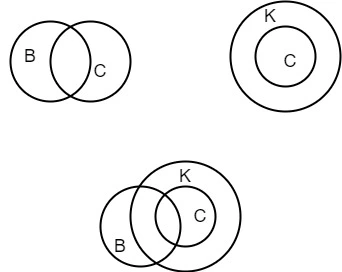
Q.5 The figure below shows the front and rear view of a disc, which is shaded with identical patterns. The disc is flipped once with respect to any one of the fixed
axes 1-1, 2-2 or 3-3 chosen uniformly at random. What is the probability that the disc DOES NOT retain the same front and rear views after the flipping operation?
(A) 0
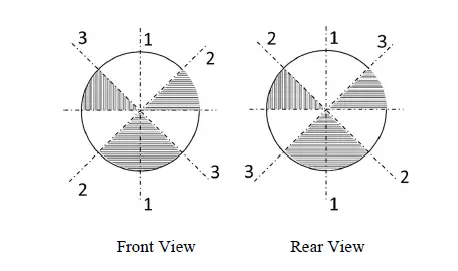
(B) 1/3
(C) 2/3
(D) 1
Ans.(C) 2/3
Ans. Given that there are 3 disc . So let us consider n= Total = 3
m= favourable = disc does not retain same front and rear view after flipping = 2
So the probability that disc does not retain the same front views after flipping operation is
Probability =m/n = 2/3
Q. 6 – Q. 10 Carry TWO marks each.
Q.6 Altruism is the human concern for the wellbeing of others. Altruism has been shown to be motivated more by social bonding, familiarity and identification of
belongingness to a group. The notion that altruism may be attributed to empathy or guilt has now been rejected. Which one of the following is the CORRECT logical inference based on the information in the above passage?
(A) Humans engage in altruism due to guilt but not empathy
(B) Humans engage in altruism due to empathy but not guilt
(C) Humans engage in altruism due to group identification but not empathy
(D) Humans engage in altruism due to empathy but not familiarity
Ans. (C) Humans engage in altruism due to group identification but not empathy
Q.7 There are two identical dice with a single letter on each of the faces. The following six letters: Q, R, S, T, U, and V, one on each of the faces. Any of the
six outcomes are equally likely. The two dice are thrown once independently at random. What is the probability that the outcomes on the dice were composed only of any combination of the following possible outcomes: Q, U and V?
(A) 1/4
(B) 3/4
(C) 1/6
(D) 5/36
Ans. (A) 1/4
Solution :- There are two dice meas each dice has 6 letters so
The probability that the outcomes on the dice is combination of Q,U and V is
P(E) = frac{Favourable}{Total} = frac{3}{6}times frac{3}{6}
P(E) = frac{1}{4}
Q.8 The price of an item is 10% cheaper in an online store S compared to the price at another online store M. Store S charges ₹ 150 for delivery. There are no
delivery charges for orders from the store M. A person bought the item from the store S and saved ₹ 100. What is the price of the item at the online store S (in ₹) if there are no other charges than what is described above?
(A) 2500
(B) 2250
(C) 1750
(D) 1500
Ans.(B) 2250
Solution:- According to the given information there are two online stores S and M,
Assume Cap price on store M is x
Price on S = (x-0.1 x) = 0.9 x
So Delivery charges on S = Rs. 100 (Given)
x-(0.9x + 150) = 100
0.1x-150 = 100
x= 2500
Therefore price on store S = 0.9 x = 0.9 x 2500 = 2250
Q.9 The letters P, Q, R, S, T and U are to be placed one per vertex on a regular convex hexagon, but not necessarily in the same order. Consider the following statements:
The line segment joining R and S is longer than the line segment joining P and Q.
The line segment joining R and S is perpendicular to the line segment joining P and Q.
The line segment joining R and U is parallel to the line segment joining T and Q.
Based on the above statements, which one of the following options is CORRECT?
(A) The line segment joining R and T is parallel to the line segment joining Q and S
(B) The line segment joining T and Q is parallel to the line joining P and U
(C) The line segment joining R and P is perpendicular to the line segment joining U and Q
(D) The line segment joining Q and S is perpendicular to the line segment joining R and P
Ans. (A) The line segment joining R and T is parallel to the line segment joining Q and S
Q.10 An ant is at the bottom-left corner of a grid (point P) as shown above. It aims to move to the top-right corner of the grid. The ant moves only along the lines
marked in the grid such that the current distance to the top-right corner strictly decreases. Which one of the following is a part of a possible trajectory of the ant during the movement?
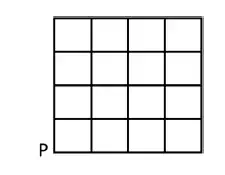
| (A) |  |
| (B) |  |
| (C) |  |
| (D) |  |
Ans. (C)
Q.11 – Q.35 Carry ONE mark Each
Q.11 The transfer function of a real system, ????(????), is given as:
H(s)=frac{As+B}{s^{2}+Cs+D} ,
where ????, ????, ???? and ???? are positive constants. This system cannot operate as
(A) low pass filter.
(B) high pass filter.
(C) band pass filter.
(D) an integrator.
Ans.(B) or (D)
Solution: he given transfer function is
H(s)=frac{As+B}{s^{2}+Cs+D}We know that at low frequency (s=0)
H(0)=frac{B}{D}At high frequency is s= ∞
H(∞)=0
It is fact that for high pass filer s(∞) should be non-zero. So the above system is not operated as HPf. Therefore option (b) is correct.
Q.12 For an ideal MOSFET biased in saturation, the magnitude of the small signal current gain for a common drain amplifier is
(A) 0
(B) 1
(C) 100
(D) infinite
Ans.(D) infinite
Solution:-We know Voltage gain Av = 1
Therefore current gain , A_i = frac{signal ;current}{Gate/;current}=frac{i_s}{i_G}=frac{i_s}{0}=infty
So option (d) is correct
Q.13 The most commonly used relay, for the protection of an alternator against loss of excitation, is
(A) offset Mho relay.
(B) over current relay.
(C) differential relay.
(D) Buchholz relay.
Ans. (A) offset Mho relay.
Solution: For protecting loss of excitation we use offset Mho relay .The offset mho relay is operated from AC current and voltage at the generator terminals.
Q.14 The geometric mean radius of a conductor, having four equal strands with each strand of radius ‘????’, as shown in the figure below, is
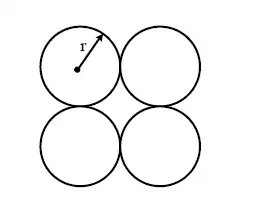
(A) 4 ????
(B) 1.414 ????
(C) 2 ????
(D) 1.723 r
Ans. (D) 1.723 r
Solution: The Geometric mean radius of a conductor having four strands is given by,
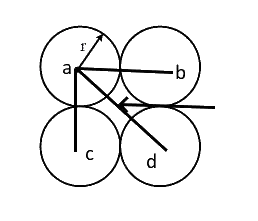
Consider Daa = Diameter ofstrand A , Dab = Diameter of strand B, Dac=diameter of strand C , Dad=Diameter of strand D
Daa= e-1/4 r
Dab= 2r
Dac= 2r
Dad = 2 sqrt{2}
GMR=[Daa Dab Dac Dad]1/4
GMR= [e-1/4 r . 2r.2r.2 sqrt{2} ]1/4
GMR= 1.723 r
The geometric mean radius is 1.723 r
So, option(d) is correct answer
Q.15 The valid positive, negative and zero sequence impedances (in p.u.), respectively, for a 220 kV, fully transposed three-phase transmission line, from the given choices are
(A) 1.1, 0.15 and 0.08
(B) 0.15, 0.15 and 0.35
(C) 0.2, 0.2 and 0.2
(D) 0.1, 0.3 and 0.1
Ans. (B) 0.15, 0.15 and 0.35
Solution: Assume that for 3-φ full transferred transmission line is
X1 ≅ X1 < Xo
According to the options we will take option B as it correctly depicts the scenario and as per condition of full transferred transmission line the option matches correctly
So, X1=X2 = 0.15
Xo= 0.35
Q.16 The steady state output (????out), of the circuit shown below, will
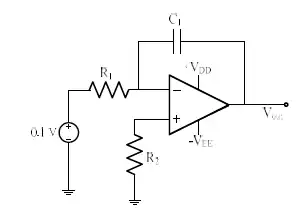
(A) saturate to +VDD
(B) saturate to -VEE
(C) become equal to 0.1 V
(D) become equal to –0.1 V
Ans. (B) saturate to -VEE
Solution:- The given figure is
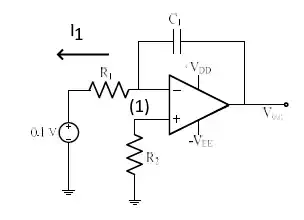
Now applying KCL at node (i)
I1+I2 = 0
frac{V_{1}-0}{R_{1}}+C_{1}times frac{d}{dt}(V_{out}-0)=0 frac{dV_{out}}{dt}=frac{V_{1}}{R_{1}C_{1}}As VA=0
V_{out}=frac{1}{R_{1}C_{1}}int V_{i}dtGiven that Vi=0.1 V
V_{out}=frac{1}{R_{1}C_{1}}int_{t}0.1dt=frac{0.1}{R_{1}C_{1}}Vout= -k x t
So the output will saturate at -VEE
Option (b) is correct.
Q.17 The Bode magnitude plot of a first order stable system is constant with frequency. The asymptotic value of the high frequency phase, for the system, is −180o . This system has
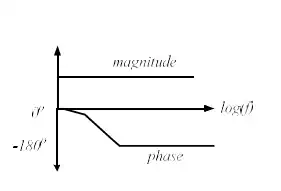
(A) one LHP pole and one RHP zero at the same frequency.
(B) one LHP pole and one LHP zero at the same frequency.
(C) two LHP poles and one RHP zero.
(D) two RHP poles and one LHP zero.
Ans. (A) one LHP pole and one RHP zero at the same frequency.
Solution:- From the Bode plot we get P=1
There are several possibilities that
frac{s-1}{s+1},frac{1-s}{1+s}Number of poles =1 and the no. of zeros is Z=1 . So option (a) is correct
Q.18 A balanced Wheatstone bridge ???????????????? has the following arm resistances:
????AB = 1 ????Ω ± 2.1% ; ????BC = 100 Ω ± 0.5% ; ????CD is an unknown resistance; RDA = 300 Ω ± 0.4%. The value of ????CD and its accuracy is
(A) 30 Ω ± 3 Ω
(B) 30 Ω ± 0.9 Ω
(C) 3000 Ω ± 90 Ω
(D) 3000 Ω ± 3 Ω
Ans. (B) 30 Ω ± 0.9 Ω
Solution: It is given that ABCD is a balanced Wheatstone bridge and ????AB = 1 ????Ω ± 2.1% ; ????BC = 100 Ω ± 0.5% ; RDA = 300 Ω ± 0.4%.
We know that in a balanced wheatsone bridge, the resistance across CD is given by,
R_{CD}=frac{R_{BC}times R_{DA}}{R_{AB}}=frac{(100pm 0.5%)(300pm 0.4%)}{(1000pm 2.1%)} R_{CD}=frac{100times 300}{1000}+(0.5%+0.4%+2.1%) = 30pm 3%Its accuracy is calculated as, %Error = ± 3 %
R_{CD}=30pm 30times frac{3}{100}=30pm 0.9; OmegaTherefore, the option (B) is correct.
Q.19 The open loop transfer function of a unity gain negative feedback system is given by G(s)=frac{k}{s^{2}+4s-5} . The range of ???? for which the system is stable, is
(A) ???? > 3
(B) ???? < 3
(C) ???? > 5
(D) ???? < 5
Ans. (C) ???? > 5
Solution: The given transfer function is G(s)=frac{k}{s^{2}+4s-5}
The characteristics equation of the given transfer function is
s2+2s+(K-5)=0
Applying Routh table analysis,
k>5 and k>0
We know that for stable system k>5
So, the range of k for which system is stable is k>5. Therefore, option (c) is correct.
Q.20 Consider a 3 x 3 matrix ???? whose (????,????)-th element, ????i,j = (???? − ????)3. Then the matrix ???? will be
(A) symmetric.
(B) skew-symmetric.
(C) unitary.
(D) null.
Ans.(B) skew-symmetric.
Solution: Let A be the3 x3 matrix ,
A=[aij]3×3 , aij=(i-j)3
We will assume two condition
i) For i=j , aij=(i-j)3 = 0
ii) for i ≠ j , aij= (i-j)3 = -(-j-i)3 n= -(j-i)3 = -aji
Therefore, A3×3 is a skew-symmetric matrix because number of rows and columns are equal and the given matrix is equal to the negative of its transpose.
Q.21 In the circuit shown below, a three-phase star-connected unbalanced load is connected to a balanced three-phase supply of 100√3 ???? with phase sequence ????????????. The star connected load has ????A = 10 Ω and ????B = 20∠60o Ω. The value of ????C in Ω, for which the voltage difference across the nodes ???? and ????′ is zero, is
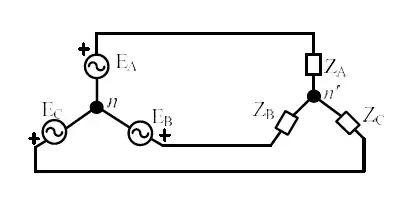
(A) 20∠−30o
(B) 20∠30o
(C) 20∠−60o
(D) 20∠60o
Ans. (C) 20∠−60o
Solution: Let two neutral points are n and n’ . So they are at same potential.
So, IA+ IB+IC = 0
We know the ohm’s law = V=IR
It is equivalent to E=IZ
IA= frac{E_A}{Z_A}
IB= frac{E_B}{Z_B}
IC= frac{E_C}{Z_C}
frac{E_A}{Z_A} + frac{E_B}{Z_B} + frac{E_C}{Z_C} =0
Putting values of all parameters
frac{100angle 0^{o}}{10}+frac{100angle -120^{o}}{20angle 60^{o}}+frac{100angle 120^{o}}{Z_c}=010 + 5∠-180o + frac{100angle 120^{o}}{Z_c} = 0
Zc = 20 ∠-60o Ω
Q.22 A charger supplies 100 W at 20 V for charging the battery of a laptop. The power devices, used in the converter inside the charger, operate at a switching frequency of 200 kHz. Which power device is best suited for this purpose?
(A) IGBT
(B) Thyristor
(C) MOSFET
(D) BJT
Ans. (C) MOSFET
Solution: The power device which is used in converter inside the charger is MOSFET.
Q.23 A long conducting cylinder having a radius ‘b’ is placed along the z axis. The current density is overrightarrow{J}=J_{a}r^{3}hat{z} for the region r < b where r is the distance in the radial direction. The magnetic field intensity (H) for the region inside the conductor (i.e. for r < b) is
(A) frac{J_{a}}{4}
(B) frac{J_{a}}{3}
(C) frac{J_{a}}{5}
(D) Jar3
Ans.(C) frac{J_{a}}{5}
Solution: It is given that overrightarrow{J}=J_{a}r^{3}hat{z}
I=int _{s}overrightarrow{J}cdot overrightarrow{ds} –(i)
overrightarrow{ds} = r dr dφ hat{z}
Putting value of hat{z} in eq.(i)
I=int <em>{s}J</em>{a}r^{3}hat{z}cdot r; drdphi hat{z} I=int {s}J{a}int_{r=0}^{r}r^{4}drint_{phi =0 }^{2pi}dphi I=J_{a}frac{r^{5}}{5}|{0}^{r}cdot phi |^{2pi }{0} I=frac{J_{a}(2pi )r^{5}}{5}We know that, oint overrightarrow{H}cdot overrightarrow{dL}=I_{enc}=int _{s}overrightarrow{J}cdot overrightarrow{ds}
H(2pi r)=frac{J_{a}(2pi )r^{5}}{5}Therefore, H= frac{J_ar^{4}}{5}
Q.24 The type of single-phase induction motor, expected to have the maximum power factor during steady state running condition, is
(A) split phase (resistance start).
(B) shaded pole.
(C) capacitor start.
(D) capacitor start, capacitor run.
Ans. (D) capacitor start, capacitor run
Solution: The capacitor start, capacitor run induction motor generally expected to have maximum power factor at steady state condition. They have higher efficiency than the motor that run on main windings. Therefore, they have maximum power factor.
Q.25 For the circuit shown below with ideal diodes, the output will be
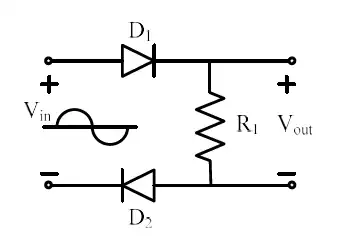
(A) ????out = ????in for ????in > 0
(B) ????out = ????in for ????in < 0
(C) ????out= −????infor ????in > 0
(D) ????out= −????in for ????in < 0
Ans. (A) ????out = ????in for ????in > 0
Solution: Let us consider two cycles, one is positive half cycle and the other is negative half cycle.
During positive half cycle, diode D1 and D3 will be ON condition
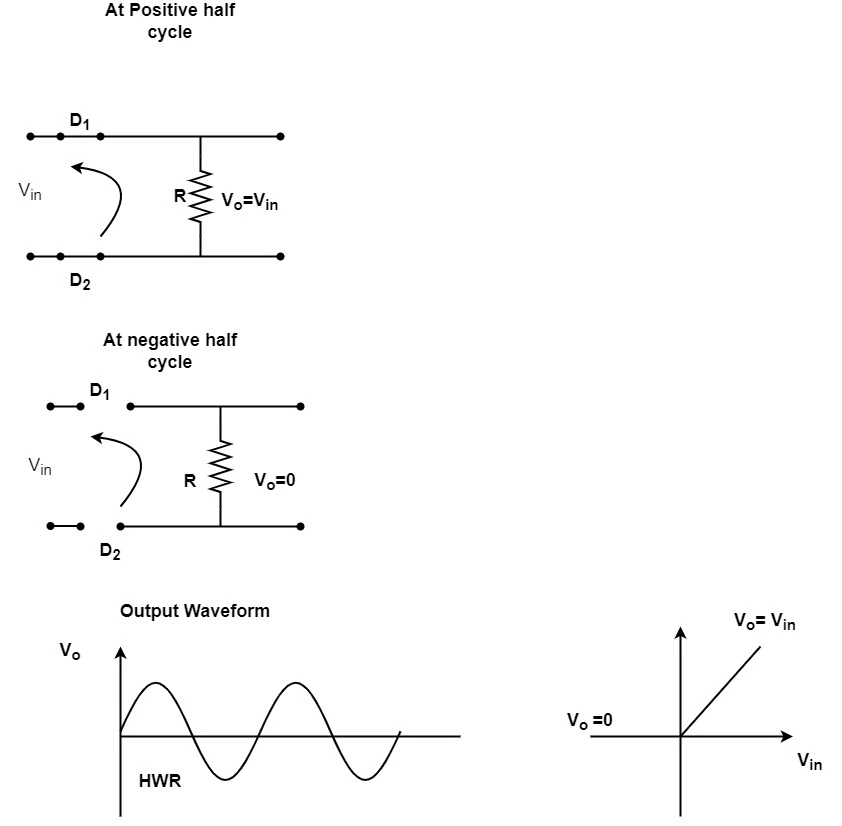
During negative half cycle, D1 and D2 will be OFF.
The output waveform is ,
Therefore, Vo=Vin for Vin > 0
Therefore, option (A) is correct .
Q.26 A MOD 2 and a MOD 5 up-counter when cascaded together results in a MOD __ counter. (in integer)
Ans. 10 to 10
Solution: The two MOD are cascaded together in series. MOD 2 and MOD-5 counter are connected in series.

So, the overall configuration = MOD(2 x 5) = 10
Therefore, the mod will have 10 counter.
Q.27 An inductor having a ????-factor of 60 is connected in series with a capacitor having a ????- factor of 240. The overall ????-factor of the circuit is __. (round off to nearest integer)
Ans. 48 to 48
Solution: The Q-factor can be calculated as,
Q=frac{Q_{L}Q_{C}}{Q_{L}+Q_{C}}The Q factor of capacitor is QC = 240 and Q-factor of inductor is QL =60
Q=frac{60times 240}{60+240}=48Q=48
Q.28 The network shown below has a resonant frequency of 150 kHz and a bandwidth of 600 Hz. The ????-factor of the network is __. (round off to nearest integer)
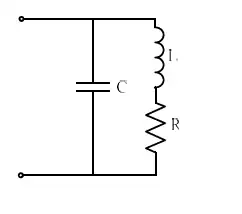
Ans. 250 to 250
Solution: The given network has 150 kHz resonant frequency
i.e. fo= 150 kHz
It has bandwidth of 600 Hz
Bandwidth B.W = 600 Hz
The Q-factor of the network is
Q= frac{f_o}{Bandwidth} = frac{150k}{600} = 250
Q.29 The maximum clock frequency in MHz of a 4-stage ripple counter, utilizing flipflops, with each flip-flop having a propagation delay of 20 ns, is _.
(round off to one decimal place)
Ans. 12.3 to 12.7
Solution: According to the given condition, there are 4 stage ripple counter so there are 4 flip-flop, means tp=20 n sec for each flip flop
And we know that, T= n tp = 4 x 20 n sec = 80 nsec
Clock frequency = frac{1}{T}=frac{1}{4times 20times 10^{-9}}= 12.5 MHz
Therefore the clock frequency is 12.5 MHz
Q.30 If only 5% of the supplied power to a cable reaches the output terminal, the power loss in the cable, in decibels, is _. (round off to nearest integer)
Ans. 13 to 13
Solution: It is given that the power loss is 5 % so let us assume3 that the total powr is 100%
So therefore the % power loss = 95%
Power output as a % of power is 5%
Practically cables power loss is measured in decibels can be evaluated as
Power loss in decibels = 10 ; logleft ( frac{95}{5} right )=12.78approx 13 ; db
So, the power loss in decibels is 13 db.
Q.31 In the circuit shown below, the switch ???? is closed at ???? = 0. The magnitude of the steady state voltage, in volts, across the 6 Ω resistor is _. (round off to two decimal places).
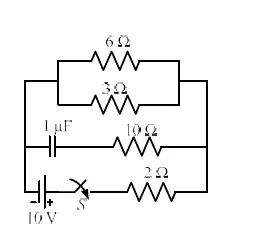
Ans. 4.95 to 5.05
Solution: It is given that the switch S is closed at t=0. For DC supply, at steady state the capacitor acts as an open circuit . The capacitor has a voltage across it, but no current flows through the circuit , therefore it acts as an open circuit.
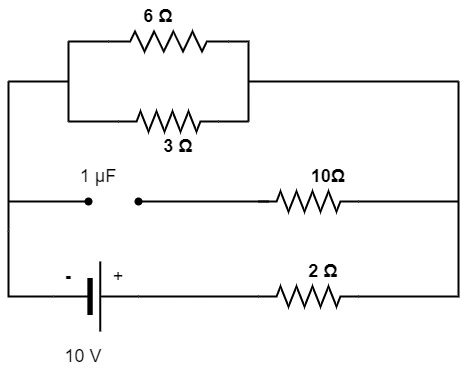
For finding voltage across 6 ohm resistor we will use the voltage division rule,
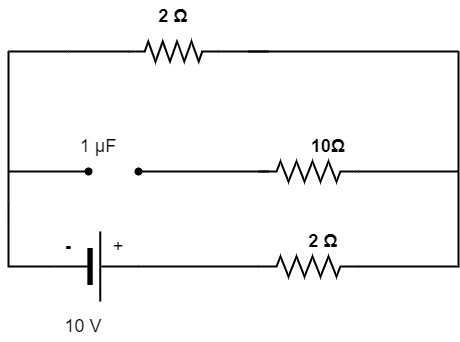
The voltage across 6 ohm resistor is 5V.
Q.32 A single-phase full-bridge diode rectifier feeds a resistive load of 50 Ω from a 200 V, 50 Hz single phase AC supply. If the diodes are ideal, then the active power, in watts, drawn by the load is _. (round off to nearest integer).
Ans. 795 to 805
Solution: It is given that the full bridge diode rectifier feeds a resistive load , means load R= 50 Ω
Now, in a single phase active power supply the voltage source is given by, Vs= 200 Volts
Now Let us calculate the average power.
The average power( which is also called as active power) is given by,
Poavg = frac{V_orms^2}{R}
Vorms = Vsrms = 200 {For single phase full bridge rectifier)
Poavg = frac{200^2}{50}=800 W
Therefore, the active power drawn by the load is 800 W.
Q.33 The voltage at the input of an AC-DC rectifier is given by ????(????) = 230√2 sin ???????? where ???? = 2???? × 50 rad/s. The input current drawn by the rectifier is given by
i(t)=10 sin left ( omega t-frac{pi }{3} right )+4 ; sin left ( 3omega t-frac{pi }{6} right )+3 sinleft ( 5omega t-frac{pi }{3} right )
The input power factor, (rounded off to two decimal places), is, _____ lag.
Ans. 0.43 to 0.47
Solution: The rms value of current is given by I_{rms}=frac{I}{sqrt{2}}
Assume that the input power factor = g
The input power is given by, g=frac{I_{s1}}{I_{sr}}=frac{10/sqrt{2}}{sqrt{left ( frac{10}{sqrt{2}} right )^{2}+left ( frac{4}{sqrt{2}} right )^{2}+left ( frac{3}{sqrt{2}} right )^{2}}}
g = 0.89 (lag)
P.F= g. FDF
PF = g. cosfrac{pi}{3} = 0.447
PF= 0.447
Q.34 Two balanced three-phase loads, as shown in the figure, are connected to a 100√3 V, three-phase, 50 Hz main supply. Given ????1 = (18 + ????24) Ω and Z2 = (6 + ????8) Ω . The ammeter reading, in amperes, is _. (round off to nearest integer)
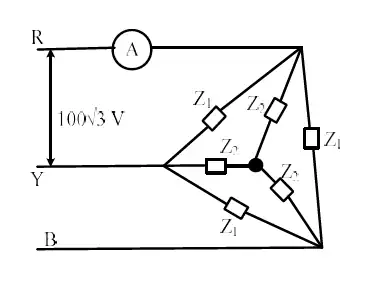
Ans. 20 to 20
Solution: Given network is star network
Now converting the delta network into star network
Z_{1}'=frac{Z_{1}times Z_{1}}{Z_{1}+Z_{1}+Z_{1}}=frac{Z_{1}}{3}=frac{18+j24}{3}=(6+j8); OmegaSimplifying the circuit we get
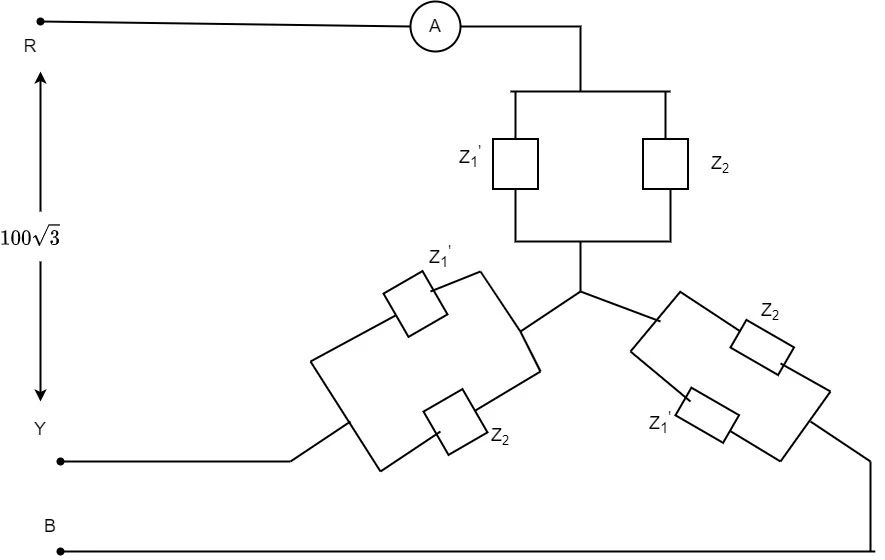
Now calculating the equivalent impedance
Zeq= Z1′ || Z2
= (6+j8) || (6+j8)
Zeq= 3+j4
For calculating the ammeter reading phase current = line current
IR= IPh= frac{V_RY}{Z_eq} = frac{100{3+j4}= 20 A
So, the ameter reading is 20 A.
Q.35 The frequencies of the stator and rotor currents flowing in a three-phase 8-pole induction motor are 40 Hz and 1 Hz, respectively. The motor speed, in rpm, is _____. (round off to nearest integer).
Ans. 580 to 590
Solution: It is given that the stator frequency = 40 Hz , and the rotor frequency is 1 Hz
Poles are 8 , N=?
The given slip is 1
sf=1
s= 1/f = 1/40 = 0.025
Ns= frac{120times 40}{8} = 600
The synchronous speed is calculated as
N= Ns(1-s)
N= 600 (1-0.025) = 585 rpm
N= 585 rpm
Q.36 – Q.65 Carry TWO marks Each
Q.36 The output impedance of a non-ideal operational amplifier is denoted by Zout . The variation in the magnitude of Z୭୳୲ with increasing frequency, f, in the circuit shown below, is best represented by
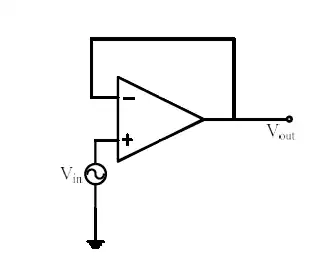
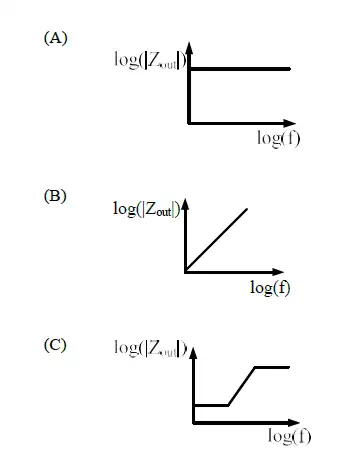
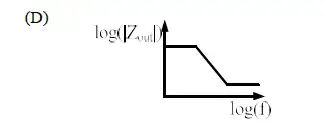
Ans. (C)
Solution: The given figure is

From this figure we can predict that it is a voltage series feedback.
Voltage is connected in shunt .
The Zout = Z_out=frac{Z_o}{1+A} = frac{Z_o}{1+A}
A is an open loop gain
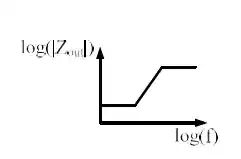
As Zout increases the constant A decreases
A=0
Now putting value of constant in Zout
Z_out=frac{Z_o}{1+0} = Z_oFrom this analysis we will assume option c as correct answer.
Q.37 An LTI system is shown in the figure where G(s)=frac{100}{s^{2}+0.1 s +10} . The steady state output of the system, to the input ????(????), is given as ????(????) = ???? + ???? ????????????(10???? + ????). The values of ‘????’ and ‘????’ will be

(A) ???? = 1, ???? = 10
(B) ???? = 10, ???? = 1
(C) ???? = 1, ???? = 100
(D) ???? = 100, ???? = 1
Ans.(A ) ???? = 1, ???? = 10
Solution: B=A|G(jω)|
Replacing value of s into jω
a=1times |frac{100}{100-omega ^{2}+0.1jomega }|_{omega =0} = 1
b=0.1times |frac{100}{100-omega ^{2}+0.1jomega }|_{omega =10} = 10
So, option (a) is correct
Q.38 The open loop transfer function of a unity gain negative feedback system is given as
G(s)=frac{1}{s(s+1}.
The Nyquist contour in the ????-plane encloses the entire right half plane and a small neighbourhood around the origin in the left half plane, as shown in the figure below. The number of encirclements of the point (−1 + ????0) by the Nyquist plot of ????(????), corresponding to the Nyquist contour, is denoted as ????. Then ???? equals to
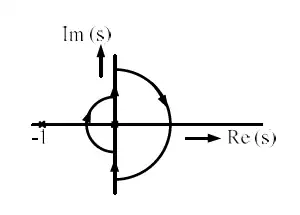
(A) 0
(B) 1
(C) 2
(D) 3
Ans. (B) 1
Solution: Here N= number of encirclement
N= 1
means In the given figure the number of encirclement is 1.
Q.39 The damping ratio and undamped natural frequency of a closed loop system as shown in the figure, are denoted as ???? and ????n, respectively. The values of ???? and ????n are
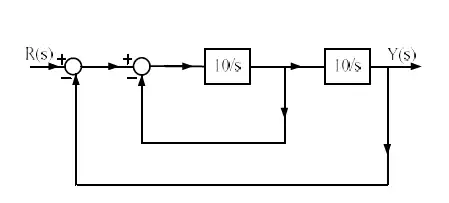
(A) ???? = 0.5 and ????n = 10 rad/s
(B) ???? = 0.1 and ????n = 10 rad/s
(C) ???? = 0.707 and ????n = 10 rad/s
(D) ???? = 0.707 and ????n = 100 rad/s
Ans. (A) ???? = 0.5 and ????n = 10 rad/s
Solution: From the figure we can depict the transfer function so, after simplifying the figure we get transfer function as,
frac{C(s)}{R(s)}=frac{100}{s^{2}+10s+100}Comparing this equation with the standard equation
frac{omega {n}^{2}}{s^{2}+2xi omega {n}s+omega _{n}^{2}}ωn=10 rad/sec
ξ=0.5
Therefore, option (a) is correct.
Q.40 ????A denotes the exponential of a square matrix A. Suppose ???? is an eigenvalue and ???? is the corresponding eigen-vector of matrix A.
Consider the following two statements:
Statement 1: e???? is an eigenvalue of ????A.
Statement 2: ???? is an eigen-vector of ????A.
.
Which one of the following options is correct?
(A) Statement 1 is true and statement 2 is false.
(B) Statement 1 is false and statement 2 is true.
(C) Both the statements are correct.
(D) Both the statements are false.
Ans. (C) Both the statements are correct.
Solution: The λ is an eigen value of A.
We know the formula
e^{A}=1+A+frac{A^{2}}{2!}+frac{A^{3}}{3!}+…and
1+lambda +frac{lambda^{2}}{2!}+…=e^{lambda}Therefore, from this we can say that statement 1 is true
Generally eigen vector of A and polynomial matrix in A is same.
Eigen vector of A and eA is same.
So statement (2) is also correct.
So answer is (c)
Q.41 Let f(x)=int_{0}^{x}e^{t}(t-1)(t-2)dt Then ????(????) decreases in the interval
(A) ???? ∈ (1,2)
(B) ???? ∈ (2,3)
(C) ???? ∈ (0,1)
(D) ???? ∈ (0.5,1)
Ans. (A) ???? ∈ (1,2)
Solution: Given that, f(x)=int_{0}^{x}e^{t}(t-1)(t-2)dt
f(x) decreases if f'(x)=0
Now by applying Leibnitz rule,
f'(x)= frac{d}{dx} f(x) < 0
Putting value of f(x) in the Leibnitz rule,
f'(x) = ex(x-1)(x-2) frac{d}{dx}(x) – [eo(0-1)(0-2) x frac{d}{dx}(0)
Taking differentiation , we get
f'(x) = [ex(x-1)(x-2)]-0 , 0
f(x) = (x-1)(x-2) < 0
= x> 1 and x < 2
f(x) = x ∈ (1,2)
So, correct option is (a).
Q.42 Consider a matrix
begin{bmatrix}1 & 0 & 0\0& 4 & -2\ 0 & 1 & 1end{bmatrix}The matrix A satisfies the equation 6A-1 = ????2 + ???????? + ????????, where ???? and ???? are scalars and ???? is the identity matrix. Then (???? + ????) is equal to
(A) 5
(B) 17
(C) −6
(D) 11
Ans. (A) 5
Solution: Given , matrix A= begin{bmatrix}1 & 0 & 0\0& 4 & -2\ 0 & 1 & 1end{bmatrix}
Here c,d are scalars and I is the identity matrix
By solving the matrix we get, λA=1
It is given that 6A-1= A2+cA+dI
Substituting A= λ
6λ-1 = λ2+cλ+d
frac{6}{1} = 1+c+d
c+d = 5
Therefore, option (a) is correct.
Q.43 The fuel cost functions in rupees/hour for two 600 MW thermal power plants are given by
Plant 1: ????1 = 350 + 6????1 + 0.004????12
Plant 2: ????2 = 450 + ????????2 + 0.003????22
where ????1 and ????2 are power generated by plant 1 and plant 2, respectively, in MW and ???? is constant. The incremental cost of power (????) is 8 rupees per MWh. The two thermal power plants together meet a total power demand of 550 MW. The optimal generation of plant 1 and plant 2 in MW, respectively, are
(A) 200, 350
(B) 250, 300
(C) 325, 225
(D) 350, 200
Ans. (B) 250, 300
Solution: Given are the two plants whose fule cost functions are
Plant 1: ????1 = 350 + 6????1 + 0.004????12
Plant 2: ????2 = 450 + ????????2 + 0.003????22
P1 and P2 are power generated
C1(P1) = 0.008 P1 + 6
C2(P2) = 0.006 P2 + a
C1= C2 = λ=8
C1 = 8
Substituting value of C1
0.008P1 + 6 = 8
P1= 250
Similarly, solving for P2,
P1= 250 MW , P2 = 300 MW
Therefore, option (b) is correct.
Q.44 The current gain (Iout/Iin) in the circuit with an ideal current amplifier given below is
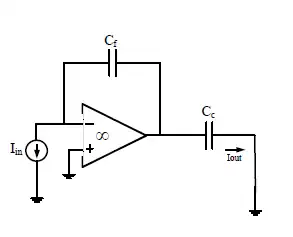
(A) frac{C_f}{C_c}
(B) – frac{C_f}{C_c}
(C) frac{C_c}{C_f}
(D)- frac{C_c}{C_f}
Ans. (C) frac{C_c}{C_f}
Solution: Given circuit diagram is,

Let current I1 flows through the capacitor having voltage Vx
V_{x}=frac{1}{C_{f}}int I_{in}times dt=frac{I_{in}}{C_{f}}times tThe output current is given by,
I_{out}=C_{c}times frac{dV_{x}}{dt}=C_{c}times frac{d}{dt}left ( frac{I_{in}}{C_{f}}times t right )= Cc x frac{I_{in}}{C_{f}}
Therefore, frac{I_{out}}{I_{in}}=frac{C_{c}}{C_{f}}
Therefore, option (c) is correct answer.
Q.45 If the magnetic field intensity (H) in a conducting region is given by the expression, H=x^{2}hat{i}+x^{2}y^{2}hat{j}+x^{2}y^{2}z^{2}hat{k} A/m. The magnitude of the current density, in A/m2 , at ???? = 1 m, ???? = 2 m, and ???? = 1 m, is
(A) 8
(B) 12
(C) 16
(D) 20
Ans. (B) 12
Solution: Given , H=x^{2}hat{i}+x^{2}y^{2}hat{j}+x^{2}y^{2}z^{2}hat{k} A/m
We know that, bar{J}=bigtriangledown times overrightarrow{H}
The given expression is plotted in matrix form
bar{J}=begin{bmatrix} widehat{a_{x}} & widehat{a_{y}} & widehat{a_{z}} frac{partial }{partial x} & frac{partial }{partial y} & frac{partial }{partial z} x & x^{2}y^{2} & x^{2}y^{2}z^{2} end{bmatrix}Solving the determinant and taking the magnitude of J ,
We get value of overrightarrow{J}=sqrt{(4)^{2}+(8)^{2}+(8)^{2}}=12
So, option (c) is correct answer.
Q.46. Let a casual LTI system be governed by the following differential equation y(t)+frac{1}{4}frac{dy}{dt}=2x(t)
where ????(????) and ????(????) are the input and output respectively. Its impulse response is
(A) 2e^{-frac{1}{4}t}u(t)
(B) 2e^{-4t}u(t)
(C) 8e^{-frac{1}{4}t}u(t)
(D)8e-4t u(t)
Ans. (D)8e-4t u(t)
Solution: The given system is y(t)+frac{1}{4}frac{dy}{dt}=2x(t)
X(t) and y(t) are the input and output functions.
Taking Laplace transformation of the given system
Y(s)+ frac{1}{4} s.Y(s) = 2X(s)
frac{Y(s)}{X(s)}=frac{2}{1+frac{s}{4}}=frac{8}{s+4}H(s) = frac{8}{s+4}
By taking inverse L.T
H(t) = 8e-4t u(t) = impulse response of system
So, (d) is correct answer
Q.47 Let an input ????(????) = 2 sin(10????????) + 5cos(15????????) + 7sin(42????????) + 4cos(45????????) is passed through an LTI system having an impulse response,
(h(t)=2left ( frac{sin(10pi t)}{pi t} right )cos(40pi t) The output of the system is
(A) 2 sin(10????????) + 5????????????(15????????)
(B) 5????????????(15????????) + 7 sin(42????????)
(C) 7 sin(42????????) + 4????????????(45????????)
(D) 2 sin(10????????) + 4????????????(45????????)
Ans. (C) 7 sin(42????????) + 4????????????(45????????)
Solution: x(t) and H(t) is an function.
Given ????(????) = 2 sin(10????????) + 5cos(15????????) + 7sin(42????????) + 4cos(45????????)
(H(t)=2left ( frac{sin(10pi t)}{pi t} right )cos(40pi t)This sin can be written in terms of g(f) functions.
H(t) = 2g(f) cos (40 πt)
g(f) is left ( frac{sin(10pi t)}{pi t} right )
Now, by Applying Fourier transformation to the function H(t)
H(omega )=2left [ frac{G(omega -40pi )+G(omega +40pi )}{2} right ]= G(omega -40omega )+G(omega +40omega )We know that the given function is x(t)
????(????) = 2 sin(10????????) + 5cos(15????????) + 7sin(42????????) + 4cos(45????????)
Let us assume that ω1=10????, ω2=15???? , ω3=42???? , ω4= 45????
The output of LTI system is
y(t) = 7 sin (42????t)+4 cos (45????t)
Therefore, option (c) is correct answer.
Q.48 Consider the system as shown below

where ????(????) = ????(????t). The system is
(A) linear and causal.
(B) linear and non-causal.
(C) non-linear and causal.
(D) non-linear and non-causal.
Ans. (B) linear and non-causal.
Solution:
Part-1
The given system will satisfy law of superposition. So the system will be Linear.
Part-2
y(t) = x(e’)
Put, t=0,
y(0)=x(1)
Since output is depending on future value of input. So the system is non-causal.
Q.49 The discrete time Fourier series representation of a signal ????[????] with period ???? is
written as x[n]=sum_{k=0}^{N=1}a_{k}e^{j(2knpi /N)} . A discrete time periodic signal with period ???? = 3, has the non-zero Fourier series coefficients: ????_3 = 2 and ????4 = 1. The signal is
(A) 2+2e^{-jleft ( frac{2pi }{6}n right )}cosleft ( frac{2pi }{6} nright )
(B) 1+2e^{-jleft ( frac{2pi }{6}n right )}cosleft ( frac{2pi }{6} nright )
(C) 1+2e^{jleft ( frac{2pi }{6}n right )}cosleft ( frac{2pi }{6} nright )
(D) 2+2e^{jleft ( frac{2pi }{6}n right )}cosleft ( frac{2pi }{6} nright )
Ans. (B) 1+2e^{-jleft ( frac{2pi }{6}n right )}cosleft ( frac{2pi }{6} nright )
Solution:
Given that,
x\lbrack n\rbrack=\sum_{k=0}^{N-1}a_ke^{j\left(\frac{2\pi}Nkn\right)}N = 3
a-3 = 2
ak = ak-n
K = -3
a-3 = a-3+N
a-3+3 = a0
a-3 = a0
a4 = 1
a4 = a-4
a-4 =1
K = 4
a4 = a4+3 = a7
a-4 = a4+3 = a-1
a-1 = a1 = 1
a1 = a4 = 1
x\lbrack n\rbrack=\sum_{k=0}^{3-1}a_ke^{j\left(\frac{2\pi}Nkn\right)} =\sum_{k=0}^2a_ke^{j\left(\frac{2\pi}Nkn\right)} =a_0+a_1e^{j\left(\frac{2\pi}Nkn\right)}+a_2e^{j\left(\frac{2\pi}32n\right)} =2+1.e^{j\left(\frac{2\pi}3n\right)}+0 =1+e^{j\left(\frac{2\pi}3n\right)}+1 =1+e^{\frac{j2\pi}3n}+e^{\frac{j2\pi}6n}.e^{\frac{j2\pi}6n} =1+e^{\frac{j2\pi}3n}\left[e^{\frac{j2\pi}6n}+e^{\frac{-j2\pi}6n}\right] =1+2e^{\frac{j2\pi}3n}\left[\frac{e^{\frac{j2\pi}6n}+e^{\frac{-j2\pi}6n}}2\right] =1+2e^{\frac{j2\pi}3n}\cos\left(\frac{2\pi}6n\right)Q.50 Let, f(????, ????, ????) = 4????2++ 7???????? + 3????????2 . The direction in which the function ????(????, ????, ????) increases most rapidly at point ???? = (1,0,2) is
(A) 20????̂+ 7????̂
(B) 20????̂+ 7????̂+ 12widehat{k}
(C) 20????̂+ 12widehat{k}
(D) 20????̂
Ans. (B) 20????̂+ 7????̂+ 12widehat{k}
Solution:
scalar function f(x,y,z) rapidly increases in the direction of its normal vector at P.
\overline a=\triangle f =\left(i\frac\partial{\partial x}+j\frac\partial{\partial y}+k\frac\partial{\partial z}\right)f= i(8x+7y+ 3z2 )+j(7x)+k(6xz)
(∇f)(1,0,2)= 20i + 7j + 12k
Q.51 Let ???? be a region in the first quadrant of the ???????? plane enclosed by a closed curve ???? considered in counter-clockwise direction. Which of the following expressions does not represent the area of the region ?????
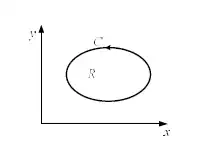
(A) int int _{R}dxdy
(B) oint _{c}x; dy
(C) oint _{c}y; dx
(D) 1/2 oint _{c}x; dy-y;dx
Ans. (C) oint _{c}y; dx
(a) \int\int_Rdxdy[katex]= Area of region R bounded by C</p> <p>By Green's </p> <p>(b) [katex] \oint xdy=\int\int_R\left(1-0\right)dxdy=Area of R bounded by C
By Green's
(c) \oint ydy=\int\int_R\left(0-1\right)dxdy= -[Area of R]
By Green's
(d) \frac12\oint_Cxdy-ydx=\frac12\int\int_R\lbrack1-(-1)\rbrack dxdy= Area of R
Q.52 Let overrightarrow{E}(x,y,z)=2x^{2}widehat{i}+5ywidehat{j}+3zwidehat{k} . The value of int int int _{V}left ( overrightarrow{bigtriangledown }.overrightarrow{E} right )dV , where ???? is the volume enclosed by the unit cube defined by 0 ≤ ???? ≤ 1, 0 ≤ ???? ≤ 1, ???????????? 0 ≤ ???? ≤ 1, is
(A) 3
(B) 8
(C) 10
(D) 5
Ans.(C) 10
\overline\nabla.\overline E=\left(i\frac\partial{\partial x}+j\frac\partial{\partial y}+k\frac\partial{\partial z}\right).(2x2i+5yj+3zk)
= 4x + 5 + 3
\int\int_V\int\overline\nabla.\overline Edv=\int_{x=0}^1\int_{y=0}^1\int_{z=0}^1(4x+5+3)dzdydx =\int_0^1\int_0^1(4x+5+3)dzdydx =\int_0^1\int_0^1{{(4xz+8z)}^1}_0dydx =\int_0^1{\left(4xy+8y\right)}_0^1dx= (2x2 + 8x)01
=10
Q.53 As shown in the figure below, two concentric conducting spherical shells, centered at r = 0 and having radii r = c and r = d are maintained at potentials such that the potential V(r) at r = c is V1 and V(r) at r = d is V2. Assume that V(r) depends only on r, where r is the radial distance. The expression for V(r) in the region between r = c and r = d is
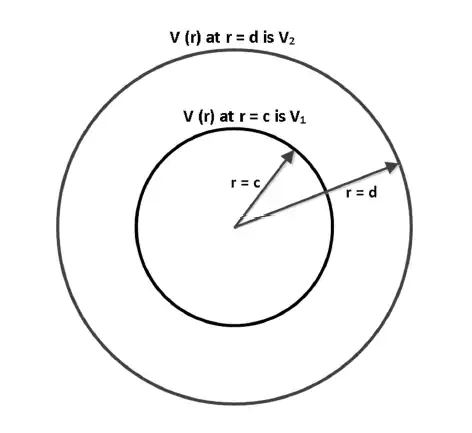
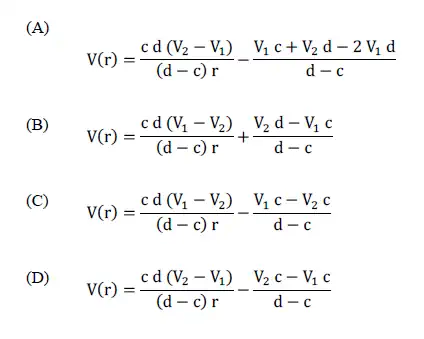
Ans.(B)
From Spherical co-ordinate system,
h1 h2 h3
1 r rsinθ
∴ \nabla^2V=\frac1{r\sin\theta}\left[\frac\partial{\partial r}\left(\frac{r^2\sin\theta}1.\frac{\partial V}{\partial r}\right)\right]=0
\Rightarrow\frac{dV}{dr}=A;A=Constant
\Rightarrow\frac{dV}{dr}=\frac A{r^2}\Rightarrow V=\frac{-A}r+B;B =Constant
at r = c; V = V1
\Rightarrow V_1=\frac{-A}r+Bat r =d;
\Rightarrow V_2=\frac{-A}d+B \Rightarrow V_1-V_2=\frac{-A}c+\frac Ad \Rightarrow V_1-V_2=A\left[\frac{c-d}{cd}\right] \Rightarrow A=\left(\frac{V_1-V_2}{c-d}\right)cdFrom (1),
B=V+ B=V_1+\frac Ac
B=V_1+\left(\frac{V_1-V_2}{c-d}\right)d∴ V=\frac{\left({\displaystyle\frac{V_1-V_2}{c-d}}\right)cd}r+V_1+d\left(\frac{V_1-V_2}{c-d}\right)
V\left(r\right)=\frac{\left(V_1-V_2\right)cd}{\left(d-c\right)r}+V_1+d\left(\frac{V_1-V_2}{d-c}\right) V\left(r\right)=\frac{\left(V_1-V_2\right)cd}{\left(d-c\right)r}+\frac{V_1d-V_1c-V_1d+V_2d}{d-c} V\left(r\right)=\frac{cd\left(V_1-V_2\right)}{\left(d-c\right)r}+\frac{V_2d-V_1c}{d-c}Q.54 Let the probability density function of a random variable ???? be given as f(x)= ae-2|x| The value of ‘a’ is ___.
Ans.0.99 to 1.01
f(x) is a p.d.f. If \int_{-\infty}^\infty f(x)dx=1
\Rightarrow\int_{-\infty}^\infty ae^{-2\left|x\right|}dx=1 \Rightarrow\int_{-\infty}^0ae^{2x}dx+\int_0^\infty ae^{-2\left(x\right)}dx=1 \Rightarrow{\left.a\frac{e^{2x}}2\right|}_{-\infty}^0+a{\left(\frac{e^{-2x}}{-2}\right)}_0^\infty=1 \Rightarrow\frac a2+\fracac a2=1a = 1
Q.55 In the circuit shown below, the magnitude of the voltage Vଵ in volts, across the 8 ????Ω resistor is __. (round off to nearest integer)
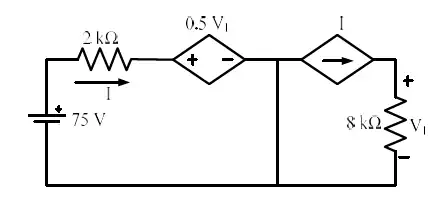
Ans. 98 to 102
The voltage across 8 kΩ is
V = 8 KI
Write kvL equation in first loop.
75=2KI+0.5V1
I=\frac{75-0.5V_1}{2k} V_1=8k\left(\frac{75-0.5V_1}{2k}\right)V1 = 100 V
Q.56 Two generating units rated for 250 MW and 400 MW have governor speed regulations of 6% and 6.4%, respectively, from no load to full load. Both the
generating units are operating in parallel to share a load of 500 MW. Assuming free governor action, the load shared in MW, by the 250 MW generating unit is
_. (round off to nearest integer)
Ans. 188 to 192 OR 198 to 202
\frac3{250}=\frac{50-f}{P_a} \frac{3.2}{400}=\frac{50-f}{500-P_a} \frac{\displaystyle\frac3{250}}{\displaystyle\frac{3.2}{400}}=\frac{500-P_a}{P_a} 1.5=\frac{500-P_a}{P_a}Pa = 200 MW
Q.57 A 20 MVA, 11.2 kV, 4-pole, 50 Hz alternator has an inertia constant of 15 MJ/MVA. If the input and output powers of the alternator are 15 MW and
10 MW, respectively, the angular acceleration in mechanical degree/s2 is __. (round off to nearest integer)
Ans.74 to 76
M\frac{d^2\partial}{dt}=P_aPa =15-10 = 5
\alpha=\frac{P_a}m m=\frac{Hs}{180f} m=\frac{15\times20}{180\times50} =\frac1{30}\alpha=\frac5{\displaystyle\frac1{30}}=150 electrical degree/sec2
\alpha=150\times\frac2P mechanical degree/sec2
α =75 mechanical degree
Q.58 Consider an ideal full-bridge single-phase DC-AC inverter with a DC bus voltage magnitude of 1000 V. The inverter output voltage ????(????) shown below, is obtained when diagonal switches of the inverter are switched with 50 % duty cycle. The inverter feeds a load with a sinusoidal current given by, ????(????) = 10 sin(???????? −π/3)A, where ???? = 2π/T. The active power, in watts, delivered to the load is (round off to nearest integer)
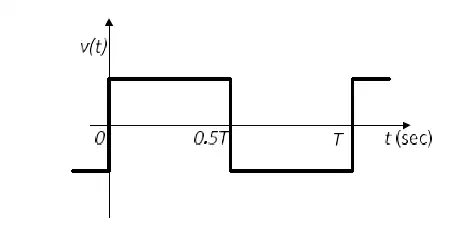
Ans. 3170 to 3190
P0 = P01
= V01.I0r.cos(600)
=\left(\frac{2\sqrt2}\pi.\left(1000\right)\right).\left(\frac{10}{\sqrt2}\right)\times\left(0.5\right)≃3182 W
Q.59 For the ideal AC-DC rectifier circuit shown in the figure below, the load current magnitude is Idc = 15 A and is ripple free. The thyristors are fired with a delay angle of 45o . The amplitude of the fundamental component of the source current, in amperes, is __. (round off to two decimal places)
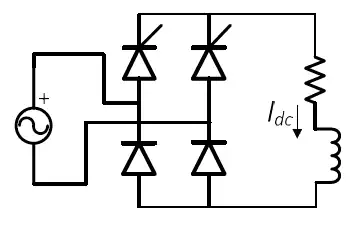
Ans.17.3 to 18
Solution:
{\widehat I}_{sn}=\frac{4.I_0}{n\pi}\cos\left(\frac{n\alpha}2\right) {\widehat I}_{sn}=\frac{4\times15}{\mathrm\pi}\cos\left(22.5^\circ\right)= 17.65 A
Q.60 A 3-phase grid-connected voltage source converter with DC link voltage of 1000 V is switched using sinusoidal Pulse Width Modulation (PWM) technique. If the grid phase current is 10 A and the 3-phase complex power supplied by the converter is given by (−4000 − ????3000) VA, then the modulation index used in sinusoidal PWM is ____ . (round off to two decimal places)
Ans. 0.46 to 0.48
Solution: Given that S= (−4000 − ????3000) VA
The power is given by,
P_{o}=sqrt{3}cdot V_{L1}cdot I_{o}(cosphi ) 4000=sqrt{3}cdot V_{L1}cdot 10times (frac{4000}{sqrt{4000^{2}+3000^{2}}} )VL1= 288.675 V
3-φ VSI - SPWM, MA ≤ 1
{\widehat V}_{L1}=\sqrt3.M_A\cdot\frac{V_s}2 {\widehat V}_{L1\left(rms\right)}=M_A\left(\frac{\sqrt3}{2\sqrt2}\times1000\right) 288.675=M_A\left(\frac{\sqrt3}{2\sqrt2}\times1000\right)MA = 0.47
Q.61 The steady state current flowing through the inductor of a DC-DC buck boost converter is given in the figure below. If the peak-to-peak ripple in the output
voltage of the converter is 1 V, then the value of the output capacitor, in µF, is ____. (round off to nearest integer)
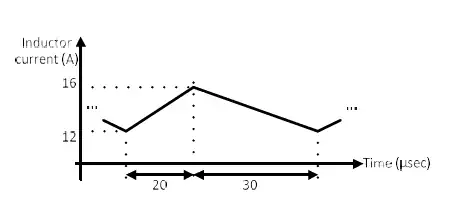
Ans. 165 to 171
Solution: Let us consider IL as inductor current and Io be the output current.
And we know that Io = IL(1-α)
I_{L}=frac{I_{max}+I_{min}}{2}=frac{16+12}{2}=14 ; ASo, with the formula we get value of IL= 14 ,
From the graph t1=20, t2= 30 , t= 50
I_{o}=I_{L}times left ( frac{t_{2}}{T} right )= 14times left ( frac{30}{50} right )= 8.4 ; AΔVo = ΔVc = frac{alpha times I_{o}}{fcdot C}
It is given that the output value of the converter is 1 V
1= frac{left ( frac{2}{5} right )times 8.4}{frac{1}{50times 10^{-6}}cdot C}
We get C= 168 μF
Q.62 A 280 V, separately excited DC motor with armature resistance of 1 Ω and constant field excitation drives a load. The load torque is proportional to the speed. The motor draws a current of 30 A when running at a speed of 1000 rpm. Neglect frictional losses in the motor. The speed, in rpm, at which the motor will run, if an additional resistance of value 10 Ω is connected in series with the armature, is __. (round off to nearest integer)
Ans. 480 to 485
Solution: It is given that V=280, The given motor is seperately excited motor , Ra= 1 Ω, φ is constant,
We know that Ta ∝ Ia, and value of this is Ta ∝ Ia = 30 A , N= 1000 rpm , Rext = 10 Ω
It is given that torque is proportional to speed
T ∝ N
Ta ∝ φ Ia
The flux constant , T φ Ia
frac{T_{2}}{T_{1}}=frac{N_{2}}{N_{1}} frac{I_a{2}}{I_a{1}}=frac{N_{2}}{N_{1}}Let Ia1= 30 A , N1= 1000 rpm
I_a_2=frac{I_a1}{N_1} = frac{30}{1000}(N_2)
The armature current is
Ia2 = 0.03 N2
Npropto frac{E_{f}}{phi } frac{N_{2}}{N_{1}}=frac{E_{b2}}{E_{b1}}=frac{V-Ia_{2}(R_{a}+R_{ext})}{V-I_{a1}R_{a}} frac{N_{2}}{1000}=frac{280-0.03N_{2}(1+10)}{280-30(1) )}=frac{280-0.33N_{2}}{250}250 N2 = 280 x 1000- 330 N2
N2 = 482.76 rpm
The speed in rpm is N2=482.76 rpm
Q.63 A 4-pole induction motor with inertia of 0.1 kg-m2 drives a constant load torque of 2 Nm. The speed of the motor is increased linearly from 1000 rpm to 1500 rpm in 4 seconds as shown in the figure below. Neglect losses in the motor. The energy, in joules, consumed by the motor during the speed change is __. (round
off to nearest integer)
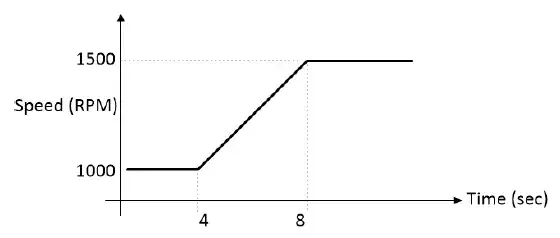
Ans. 675 to 700 OR 1725 to 1740
Solution: Given that there is 4 pole , Moment of inertia = 0.1 kg-m2,
The graph given in the figure has speed on y axis and time is on x axis.
N=125t+500
The range is 4 sec ≤t ≤ 8 sec
We know that , Jfrac{domega }{dt}=T_{e}-T_{L}
Te = Jfrac{domega }{dt}+ T_L
omega T_{e}=Jfrac{domega }{dt}+omega T_{L}P_{e}=Jomega frac{domega }{dt}+omega T_{L} --(i)
Differentiatingb eq.(i)
frac{dE}{dt}=Jomega frac{domega }{dt}+omega T_{L}It can also be written as,
dE= Jωdω + ωTL dt
E=Jint omega; domega +T_{L}int omega dtWe know that, omega =frac{2pi }{60}
E=Jleft ( frac{2pi }{60} right )^{2}int_{1000}^{1500}NdN+T_{L}left ( frac{2pi }{60} right )int_{4}^{8}N ; dt E=Jleft ( frac{2pi }{60} right )^{2}left ( frac{N^{2}}{2} right )^{1500}_{1000}+2left ( frac{2pi }{60} right )(125t+500)dt E=0.1times left ( frac{2pi }{60} right )^{2}left ( frac{1500^{2}-1000^{2}}{2} right )^{1500}{1000}+2left ( frac{2pi }{60} right )left [ frac{125t^{2}}{2}+500t right ]^{8}{4}E= 68.38+1047.19 = 1732.5865 J
E= 1732.5865 J
Q.64 A star-connected 3-phase, 400 V, 50 kVA, 50 Hz synchronous motor has a synchronous reactance of 1 ohm per phase with negligible armature resistance. The shaft load on the motor is 10 kW while the power factor is 0.8 leading. The loss in the motor is 2 kW. The magnitude of the per phase excitation emf of the motor, in volts, is __. (round off to nearest integer).
Ans. 240 to 248
Solution: Given that V= 400 V , KVA rating = 50 KVA, It is star connected, 3 phase, Xs = 1 ohm/phase,
shaft load = Psh= 10 kW , P.f= 0.8 loading losses = 2 kW , Ra is negligible.
To Find :- excitation EMF (Eb) , Ia
Formula required - E_{b}=sqrt{(V cosphi -I_{a}R_{a})^{2}+(V sinphi pm I_{a}X_{s})^{2}}
We know that (+) is for lead (-) is for lag
i) Step-I :- Calculating the Ia
For finding Ia we require input
Input = Output + Losses +Psh, Losses = 10 +2 = 12 kW
P=12 kW
sqrt{3}V_{L}I_{L}cosphi = 12 kWNow finding IL with the help of above formula we get,
I_{L}=frac{P}{sqrt{3}V_{L}times cosphi }=frac{12000}{sqrt{3}times 400times 0.8}= 21.65 ;AIL= Ia= 21.65 A
Step-II :- Calculating the Eb
E_{b}=sqrt{left ( frac{V_{L}}{sqrt{3}}times cosphi right )^{2}+left (frac{V_{L}}{sqrt{3}}times sinphi +I_{L}(X_{s}) right )^{2}}[/katex]
E_{b}=sqrt{left ( frac{400}{sqrt{3}}times 0.8 right )^{2}+left (frac{400}{sqrt{3}}times 0.6+21.65(1) right )^{2}} E_{b}=sqrt{31135.336+(138.568+21.65)^{2}}=244.55 ; VEb= 244.55 V per phase
The magnitude of per phase excitation emf of motor in volts is 244.55 V per phase.
Q.65 A 3-phase, 415 V, 4-pole, 50 Hz induction motor draws 5 times the rated current at rated voltage at starting. It is required to bring down the starting current from the supply to 2 times of the rated current using a 3-phase autotransformer. If the magnetizing impedance of the induction motor and no load current of the autotransformer is neglected, then the transformation ratio of the autotransformer is given by __. (round off to two decimal places).
Ans. 0.61 to 0.65
Solution: In the given problem we have V=415 V, f= 50 Hz, Isc= 5, Isc = 5 It
Given that it is required to bring the starting current down from the supply to 2 times of rated current. Let us assume x as transformation ratio.
Line current with auto transformer,
IL= x2 Isc
IL= 2If (Given )
frac{2I_f}{I_sc} = x^{2}x2 = 2 x frac{1}{5}
x=sqrt{frac{2}{5}}= 0.63Therefore, the transformation ratio of autotransformer is 0.63.
